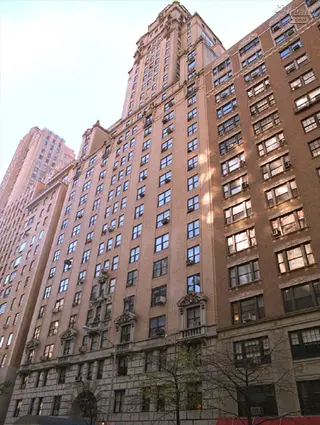 Carter Horsley
Carter HorsleyDec 23, 2011
Carter's Review
This 30-story tower is credited with ushering in "the transformation of its parkside neighborhood into one of the most architecturally distinctive areas in the city...It is one of Manhattan's finest free-standing towers of the 1920's."
That assessment was made, correctly, by Steven Ruttenbaum in his book, "Mansions in the Clouds, the Skyscraper Palazzi of Emery Roth," (Balsam Press, Inc., 1986).
What is surprising is the location of such a magnificent tower. It is not fronting on a park, or even a corner. The building almost seems too extravagant for its mid-block setting. The building's entrance is a two-story arch and it and the façade detailing "contribute a majestic and powerful quality to the building," Ruttenbaum wrote.
The tower, which was completed in 1927, has a buff brick façade above a rusticated, three-story stone base and terra-cotta window surrounds in Italian Renaissance fashion at the fourth, fifth, sixth, 15th, and 26th through the 29th stories.
The building has setbacks at the 16th, 19th, 20th, 21st 27th, and 29th floors.
The symmetrical design by Emery Roth culminates in a pointed green-glazed terra-cotta lantern on an octagonal drum.
"In the wintertime, it is possible to see steam escaping through the arched openings of the lantern, trailing off into the heavens. It is an inspirational sight to behold," according to Ruttenbaum.
"The first-floor public spaces of the Oliver Cromwell," he continued, "originally were richly decorated in an eclectic and colorful mixture of styles. The lobby was intimately scaled and embellished with classically inspired polychrome terra-cotta arches and doorways. At one end of the room was a tile fountain supporting a bust of Oliver Cromwell. The ceiling was decorated with a colorful terra-cotta cornice and was divided into a series of irregularly shaped panels with murals painting in pastel shades depicting figures in Spanish costume. The main dining room was of similar design; however, its ceiling was wood-paneled and ornamented with colorful plaster moldings. The overall effect of these details produced a rich, polychrome impression....
"Despite these fine features, however, the Oliver Cromwell was not an immediate financial success. Following the building's opening, many suites remained vacant, and when economic chaos engulfed the city shortly thereafter as a result of the stock market crash, the hotel suffered even greater financial uncertainty. In early 1932, the building went into receivership and new efforts were made to attract tenants by increasing services. At that time, occupancy, which included month-to-month rentals and long-term leases, ran less than 60 percent.
"By the end of the year, however, every apartment, both furnished and unfurnished, was under lease for at least one full year. Five years after its completion, financially stability finally found a home at the Oliver Cromwell....According to his sons, [Roth]...took special satisfaction in the design of the Oliver Cromwell. Because he considered it the finest building produced by his office, he was distressed that it was not an immediate financial success."
The 172-unit building was converted to a cooperative apartment building in 1984.
Its prominence was short-lived and diminished somewhat by the tall twin towers of the Majestic apartment house at the Central Park West corner a few years after its completion.
While the famous towers along Central Park West survived the Depression fairly well, side- and cross-street buildings did not fare as well and the Oliver Cromwell even had to resort to a large roof-top sign for a while and the opulence of its lobby and its reputation lost much of their luster, which is surprisingly since it is not much different from the Carlyle Hotel on Madison Avenue on the Upper East Side and is slightly scaled down from Roth's own Ritz Tower at the northeast corner of Park Avenue and 57th Street.

- Co-op built in 1926
- 5 apartments currently for sale ($699K to $4.195M)
- Located in Central Park West
- 172 total apartments 172 total apartments
- 10 recent sales ($383K to $6M)
- Doorman
 6sqft delivers the latest on real estate, architecture, and design, straight from New York City.
6sqft delivers the latest on real estate, architecture, and design, straight from New York City.
